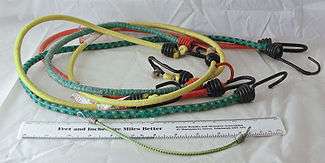Bungee cord


A bungee cord (sometimes spelled bungie), also known as a shock cord, (occy strap or octopus strap in Australian common usage) is an elastic cord composed of one or more elastic strands forming a core, usually covered in a woven cotton or polypropylene sheath. The sheath does not materially extend elastically, but it is braided with its strands spiralling around the core so that a longitudinal pull causes it to squeeze the core, transmitting the core's elastic compression to the longitudinal extension of the sheath and cord. Specialized bungees, such as some used in bungee jumping, may be made entirely of elastic strands.
Bungee cords have been used to provide a lightweight suspension for aircraft undercarriages from before World War I, and are still used on many small homebuilt aircraft where weight remains critical.[1] Bungee cords were also used in parachuting to assist in opening the old-style parachute container after the ripcord was pulled.
Today, bungee cords are most often used to secure objects without tying knots and to absorb shock. Inexpensive bungee cords, with metal or plastic hooks on each end, are marketed as a general utility item. This form is also known as kangaroo, octopus, or "occy", straps in Australia. These can be an individual strap, or a set of four hooked straps held together by a metal ring allowing the occy strap to secure items around various tie points, for example a suitcase to a car roof rack. Extensions of the concept are available as a coarse net of bungee cords with metal or plastic hooks around the periphery, for securing irregularly shaped loads of luggage and cargo on the backs of pickup trucks, roofs of cars, and so on.
Bungee cords have also been used to make bungee chairs[2] and for other purposes.
The origin of the name "bungee", bungie" or "bungy" is uncertain. The Oxford English Dictionary records the use in 1938 of the phrase bungee-launching of gliders using an elasticized cord.[3]
Bungee cords are a major source of eye injury and doctors suggest not using them.[4]
Notes
- ↑ Currey, Norman S. (1988). Aircraft landing Gear Design: Principles and Practices. AIAA Education Series. Washington, D.C.: American Institute of Aeronautics and Astronautics. ISBN 0-930403-41-X.
- ↑ Kang, Julie (January 21, 2015). "Bungee Chair 1.0". Rhode Island School of Design Portfolios. Retrieved December 6, 2015.
- ↑ "Bungee launching explained". Archived from the original on 2005-12-30. Retrieved 2006-09-28.
- ↑ http://www.webmd.com/eye-health/news/20000502/bungee-cords-eye-injury#1
| Wikimedia Commons has media related to Bungee cords. |